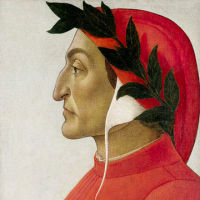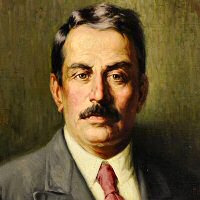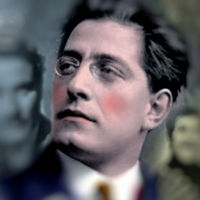

| Annotation Handout Return to Index |
5. A Family Show.
In a career devoted mainly to tragedy, Puccini consulted the Comic Muse only once, towards the end of his life.
Commissioned for a 1918 premiere at the Metropolitan Opera in New York, he took his one-act melodrama Il tabarro
(The Cloak) and added two more pieces to it, making a triptych—the so-called Trittico—all connected by
the theme of death; the additions were the convent opera Suor Angelica and the comedy Gianni Schicchi.
Though death might seem an improbable subject for a comedy, the idea of a contentious family at a wake squabbling over
the will offered plenty of farcical potential.
The subject actually derives from Dante, who shows Schicchi—an historical figure—condemned to the Inferno for the crime of impersonating a dying man, Buoso Donati, in order to forge a will. To make this work as a comedy, Puccini needed to make the Donati family totally awful (and hence comic), make Schicchi sympathetic (he is one of the great baritone roles), and give him an altruistic reason for the deception. This comes because his daughter Lauretta is in love with young Rinuccio Donati, and he wants to give them a good start. This adds a romantic layer to the opera, typified by Lauretta’s famous aria “O mio babbino caro.” Though romance is a comparatively small proportion of the whole, it gives the score its unique color.
The family tree can be confusing. Click the "Annotation" link under the image above if you want to see a graphic representation of the Donati family. Some years ago, I made a booklet with descriptions of all the characters in the opera. Although based on the facts in the score, these are strictly my own interpretations, but it may be interesting to read them. Click here for a PDF. rb.
The script, videos, and images will be posted immediately after class.
| Annotation Handout Character Sketches Class Script | Return to Index |
Q AND A
Are there any changes to this website?
Yes, two. As I mentioned before, the links no longer come up in a new window; use the back button to return to this
page. And I no longer supply the handouts in flat and folded forms. If your printer will not print on both sides,
simply fold the two pages back to back to make a booklet.
VIDEO LINKS
The videos are a mixed bag. Of the two British productions I mainly used, the Glyndebourne one is available complete, but with Spanish titles burned in; the Royal Opera one is available only in clips, which only partially duplicate those we saw in class. I also added links to the three shorter clips from other sources that we watched.
The RAI and Met Guild performances listed in the first section are in fact complete. I give links to three other complete productions with titles in English, plus one visually-fascinating one from Rome with titles only in Italian. (1) A very weird 2008 production from La Scala, musically sound but visually unsatisfying. (2) A COVID lockdown production from Grange Park acompanied only by piano and filmed in the various rooms of a large house; despite its limitations, it is one of the freshest performances out there. (3) A wonderfully baroque production from Rome, in wildly offbeat set and costumes; Italian titles only. (4) A 2025 production from Valencia, cleverly updated to the present, but available online only through November.
In addition to Kristina Mkhitaryan's performance of "O mio babbino caro" from the Met that we saw, and Ekaterina Siurina's from the Royal Opera House, both listed in the top section below, I selected four other videos from the dozens online, mostly as curiosities. (1) Renata Scotto in 1981 from the Met, as an example of old-style production and singing. (2) Andriana Churchman in a production by Woody Allen from Los Angeles. (3) A concert performance by a child, Amina Willighagen, with André Rieu, remarkable both for how well the very young girl sings, and how tastelessly Rieu dolls it up with swooning strings, backup singers, and Las Vegas setting—this one has to be seen to be believed! (4) A compilation of five divas (Maria Callas, Renata Tebaldi, Montserrat Caballé, Anna Netrebko, and Renée Fleming) singing the aria in concert.
| PRODUCTIONS SAMPLED IN CLASS | |||
| RAI television 1956 | complete, cued to will-reading | ||
| Met Opera Guild 1993 | complete, cued to will-reading (sung in English) | ||
| Glyndebourne 2004 | complete performance (Spanish titles) | ||
| Royal Opera House 2011 |
Rinuccio aria
(Francesco Demuro, not played) Lauretta aria (Ekaterina Siurina, not played) Schicchi aria (Lucio Gallo) |
||
| Metropolitan Opera 2018 | Lauretta aria (Kristina Mkhitaryan) | ||
| OTHER COMPLETE PERFORMANCES | |||
| La Scala 2008 | complete | ||
| Grange Park 2022 | complete (COVID production with piano) | ||
| Rome 2025 | complete (Italian titles only) | ||
| Valencia 2025 | complete (only through November) | ||
| OTHER VIDEOS OF LAURETTA'S ARIA | |||
| Renata Scotto | Met 1981 | ||
| Andriana Churchman | Los Angeles 2016 (production by Woody Allen) | ||
| Amina Willighagen | Concert with André Rieu (must watch—see above!) | ||
| Various artists | Compilation (Callas, Tebaldi, Caballé, Netrebko, Fleming) | ||
ARTISTS
Here are brief bios of the composers and writers considered in the class, listed in order of birth.
 |
Dante Alghieri, 1265–1321. Florentine poet. Dante is so highly regarded as the author of the Divina Commedia and founder of Italian poetry, that any capsule biography here would be superfluous. There are at least five operas based on his work: Puccini's Gianni Schicchi, plus versions of Francesca di Rimini by Mercadante, Rachmaninoff, Ambroise Thomas, and Zandonai. The portrait by Botticelli is posthumous. |
 |
Giacomo Puccini, 1858–1924. Italian composer. Puccini took up the mantle of Verdi as the dominant opera composer of the late 19th century, and developed an international popularity that is unrivaled to this day. His principal works include: Manon Lescaut (1893), La bohème (1896), Tosca (1900), Madama Butterfly (1904), and the unfinished Turandot (1926). |
 |
Giovacchino Forzano, 1884–1970. Italian playwright. Forzano wrote libretti for several early-20th-century Italian composers, but he is mainly remembered for Puccini's Suor Angelica and Gianni Schicchi, both premiered in 1918. He was a stage director at La Scala for many years, and also collaborated closely with Mussolini, co-writing several plays promoting Fascist ideals. |
• Return to top • Return to index